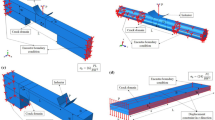Abstract
This paper presents a new method for continuum-based shape sensitivity and reliability analyses of a crack in a homogeneous, isotropic, and linear-elastic body subject to mode-I loading. The method involves the material derivative concept of continuum mechanics, domain integral representation of the J-integral, and direct differentiation. Unlike virtual crack extension techniques, no mesh perturbation is needed in the proposed sensitivity analysis method. Since the governing variational equation is differentiated prior to the process of discretization, the resulting sensitivity equations are independent of any approximate numerical techniques, such as the finite element method, boundary element method, or others. Numerical results show that the maximum error in calculating the sensitivity of Jusing the proposed method is less than three percent. Based on continuum sensitivities, the first-order reliability method was formulated to conduct probabilistic fracture-mechanics analysis. A numerical example is presented to illustrate the usefulness of the proposed sensitivity equations for probabilistic analysis. Since all gradients are calculated analytically, the reliability analysis of cracks can be performed efficiently.
Similar content being viewed by others
References
ABAQUS (1999). User's Guide and Theoretical Manual, Version 5.8, Hibbitt, Karlsson and Sorenson, Inc., Pawtucket, RI.
Anderson, T.L. (1985). Fracture Mechanics: Fundamentals and Applications, Second Edition, CRC Press Inc., Boca Raton, Florida.
Barbero, E.J. and Reddy, J.N. (1990). The jacobian derivative method for three-dimensional fracture mechanics. Communications in Applied Numerical Methods 6, 507–518.
Besterfield, G.H., Lawrence, M.A. and Belytschko, T. (1990). Brittle fracture reliability by probabilistic finite elements. ASCE Journal of Engineering Mechanics, 116, 642–659.
Besterfield, G.H., Liu, W.K., Lawrence, M.A. and Belytschko, T. (1991). Fatigue crack growth reliability by probabilistic finite elements, Computer Methods in Applied Mechanics and Engineering, 86, 297–320.
Choi, K.K. and Haug, E.J. (1983). Shape design sensitivity analysis of elastic structures. Journal of Structural Mechanics 11, 231–269.
deLorenzi, H.G. (1985). Energy release rate calculations by the finite element method. Engineering Fracture Mechanics 21, 129–143.
deLorenzi, H.G. (1982). On the energy release rate and the J-integral for 3-D crack configurations. International Journal of Fracture 19, 183–193.
Feijóo, R.A., Padra, C., Saliba, R., Taroco, E. and Vénere, M.J. (2000). Shape sensitivity analysis for energy release rate evaluations and its application to the study of three-dimensional cracked bodies. Computational Methods in Applied Mechanics and Engineering 188, 649–664.
Grigoriu, M., Saif, M.T.A., El-Borgi, S. and Ingraffea, A. (1990). Mixed-mode fracture initiation and trajectory prediction under random stresses. International Journal of Fracture 45, 19–34.
Haber, R.B. and Koh, H.M. (1985). Explicit expressions for energy release rates using virtual crack extensions. International Journal of Numerical Methods in Engineering 21, 301–315.
Hasofer, A.M. and Lind, N.C. (1974). An exact and invariant first-order reliability format. Journal of Engineering Mechanics 100, 111–121.
Haug, E.J., Choi, K.K. and Komkov, V. (1986). Design Sensitivity Analysis of Structural Systems, Academic Press, New York.
Hwang, C.G., Wawrzynek, P.A., Tayebi, A.K. and Ingraffea, A.R. (1998). On the virtual crack extension method for calculation of the rates of energy release rate. Engineering Fracture Mechanics 59, 521–542.
Keum, D.J. and Kwak, B.M. (1992a). Calculation of stress intensity factors by sensitivity analysis with respect to change of boundary conditions. Computers and Structures 44, 63–69.
Keum, D.J. and Kwak, B.M. (1992b). Energy release rates of crack kinking by boundary sensitivity analysis. Engineering Fracture Mechanics 41, 833–841.
Li, F.Z., Shih, C.F. and Needleman A. (1985). A comparison of methods for calculating energy release rates. Engineering Fracture Mechanics 21,405–421.
Lin, S.C. and Abel, J. (1988). Variational approach for a new direct-integration form of the virtual crack extension method. International Journal of Fracture 38, 217–235.
Liu, P.L. and Kiureghian, A.D. (1991). Optimization algorithms for structural reliability. Structural Safety 9, 161–177.
Madsen, H.O., Krenk, S. and Lind, N.C. (1986). Methods of Structural Safety, Prentice-Hall, Inc., Englewood Cliffs, New Jersey.
Moran, B. and Shih, C.F. (1987). A general treatment of crack tip contour integrals. International Journal of Fracture 35, 295–310.
Provan, James, W. (1987). Probabilistic Fracture Mechanics and Reliability, Martinus Nijhoff Publ., Dordrecht, The Netherlands.
Rackwitz, R. and Fiessler, B. (1978). Structural reliability under combined random load sequence. Computers and Structures 9, 489–494.
Rahman, S. and Kim, J-S. (2001). Probabilistic fracture mechanics for nonlinear structures. International Journal of Pressure Vessels and Piping, 78, 261–269.
Rahman, S., Ghadiali, N., Paul, D. and Wilkowski, G. (1995). Probabilistic pipe fracture evaluations for leakrate-detection applications. NUREG/CR-6004, U.S. Nuclear Regulatory Commission, Washington, D.C.
Rahman, S. (1995). A stochastic model for elastic-plastic fracture analysis of circumferential through-wall-cracked pipes subject to bending. Engineering Fracture Mechanics, 52, 265–288.
Rahman, S. (2001). Probabilistic fracture mechanics by J-estimation and finite element methods. Engineering Fracture Mechanics, 68, 107–125.
Rice, J.R. (1968). A path independent integral and the approximate analysis of strain concentration by notches and cracks. Journal of Applied Mechanics 35, 379–386.
Shih, C.F., Moran, B. and Nakamura, T. (1986). Energy release rate along a three-dimensional crack front in a thermally stressed body. International Journal of Fracture 30, 79–102.
Taroco, E. (2000). Shape sensitivity analysis in linear elastic cracked structures. Computational Methods in Applied Mechanics and Engineering 188, 697–712.
Author information
Authors and Affiliations
Rights and permissions
About this article
Cite this article
Chen, G., Rahman, S. & Park, Y.H. Shape sensitivity and reliability analyses of linear-elastic cracked structures. International Journal of Fracture 112, 223–246 (2001). https://doi.org/10.1023/A:1013543913779
Issue Date:
DOI: https://doi.org/10.1023/A:1013543913779




